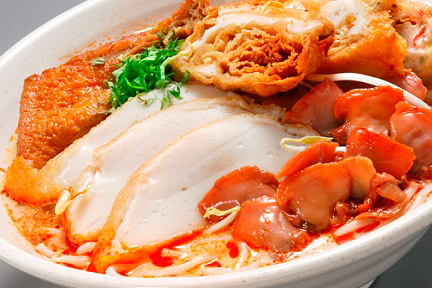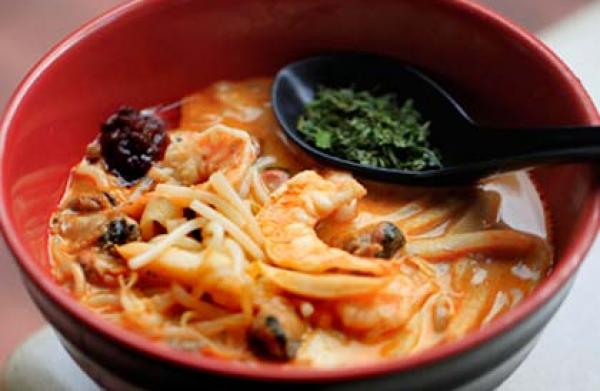Various recipes of laksas have gained popularity in Malaysia, Singapore and Indonesia; and subsequently international recognition. Initially in July 2011, CNN Travel ranked Penang Asam Laksa 7th out of the 50 most delicious foods in the world. Its rank however, fall to number 26th after CNN held an online poll by 35,000 people, published in September 2011. Singaporean Curry Laksa on the other hand ranked in number 44th.
Types
The type of laksa is based upon the soup-base employed in its recipe; either rich and savoury coconut milk, fresh and sour asam (tamarind, gelugur or kokum), or the combination of the two. There are three basic types of laksa: curry laksa, asam laksa and other variant that can be identified as either curry or asam laksa. Curry laksa is a coconut milk curry soup with noodles, while asam laksa is a sour, most often tamarind-based, soup with noodles. Thick rice noodles also known as laksa noodles are most commonly used, although thin rice vermicelli (bee hoon or mee hoon) are also common, and some recipes might create their own rice noodle from scratch. Some variants might use other types of noodles; Johor laksa for example uses spaghetti, while a fusion recipe might use Japanese udon noodle.
Etymology
Term of "laksa" may derive from the Chinese word 辣沙 (Cantonese: [làːt.sáː]), meaning "spicy sand" due to the ground dried prawns which gives a sandy or gritty texture to the sauce. "Katong" is the name of an exotic species of sea turtle now extinct. It also means the rippling effect of a sea mirage when looking at a shoreline. Katong is a residential area in the east of Singapore. Laksa Katong was created in Katong area, because of that it has named as Katong Laksa. In another version of Katong Laksa, it was popularised by brothers Ng Juat Swee and Ng Chwee Seng, who started selling the noodles in a coffee shop in East Coast Road in 1963. Four rivals had popped up along the same stretch of East Coast Road by 1999, and many of them had names with “Katong Laksa” in it
Origin
Katong Laksa originated from Katong area, Singapore. The hawker was nicknamed "Jangok" by the peranakan, because he had a few strands of hair at his chin. He was an itinerant hawker and lived in Tembling Road/Joo Chiat Terrace. Later he moved his business into the eating house at East Coast Road/Ceylon Road. (wikipedia)


- 328 Katong Laksa - 216 East Coast Road
- 328 Katong Laksa - 51 East Coast Road
- Katong Laksa - 307 Changi Rd
- Sungei Road Laksa - 27 Jalan Berseh, #01-100
- Janggut Laksa - 331 Upper Paya Lebar Road
- 928 Yishun Laksa - 928 Yishun Central 1 #01-155
- Depot Road Zhen Shan Mei Claypot Laksa - Alexandra Village Food Centre #01-75
- Wei Yi Laksa & Prawn Noodle 唯一辣沙 - Tanglin Halt Food Centre #01-20
- Sungei Road Trishaw Laksa - Hong Lim Food Centre #02-66
- Guang Fa Laksa - Havelock Cooked Food Centre #01-08
- Khoon’s Katong Laksa & Seafood Soup - Sembawang Hills Food Centre #01-26
- Terry Katong Laksa 達利加東叻沙 - Chinatown Complex Food Centre #02-91
- Terry Katong Laksa 達利加東叻沙 - Bukit Timah Food Centre #02-194
